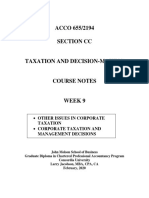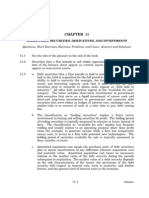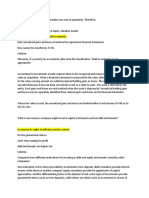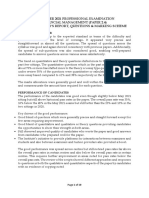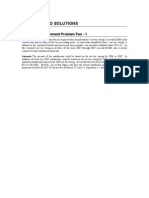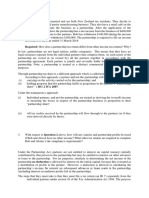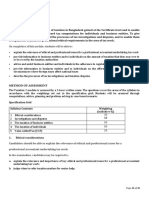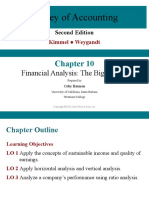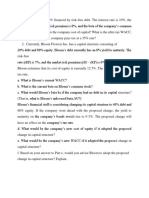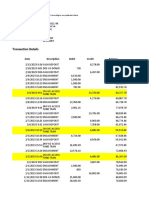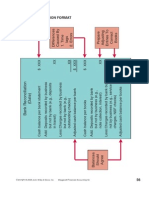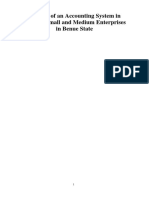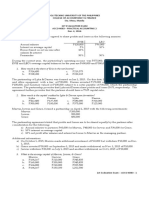Chapter 13 Online Quiz
Chapter 13 Online Quiz
Uploaded by
gottwins05Copyright:
Available Formats
Chapter 13 Online Quiz
Chapter 13 Online Quiz
Uploaded by
gottwins05Original Description:
Copyright
Available Formats
Share this document
Did you find this document useful?
Is this content inappropriate?
Copyright:
Available Formats
Chapter 13 Online Quiz
Chapter 13 Online Quiz
Uploaded by
gottwins05Copyright:
Available Formats
Chapter Quiz
http://highered.mcgraw-hill.com/sites/0073526878/stude...
Chapter Quiz
(See related pages)
Results Reporter
Out of 19 questions, you answered 19 correctly with a final grade of 100% 19 correct (100%) 0 incorrect (0%) 0 unanswered (0%)
Your Results:
The correct answer for each question is indicated by a .
Enter the letter corresponding to the response which best completes each of the following statements or questions.
1 CORRECT
The essential characteristics of a liability do not include: A) The existence of a past causal transaction or event. B) Present obligation. C) The existence of a legal obligation. D) A future sacrifice of economic benefits. Feedback: The definition of a liability is "the probable future sacrifice of economic benefits arising from present obligations of a particular entity to transfer assets or provide services to another entity in the future as a result of past transactions or events."
2 CORRECT
Of the following, which usually would not be classified as a current liability? A) A nine-month note to be paid with the proceeds from the sale of common stock. B) Bonds payable maturing within the coming year. C) Estimated warranty liability. D) Subscription revenue received in advance. Feedback: A current liability is defined as an obligation whose liquidation is reasonably expected to require use of existing resources properly classified as current assets or the creation of othercurrent liabilities.
3 CORRECT
Which of the following results in an accrued liability? A) Interest on a 6 month bank loan due in two months: Yes; Sales taxes collected on recent sales: Yes B) Interest on a 6 month bank loan due in two months: Yes; Sales taxes collected on recent sales: No C) Interest on a 6 month bank loan due in two months: No; Sales taxes collected on recent sales: No D) Interest on a 6 month bank loan due in two months: No; Sales taxes collected on recent sales: Yes Feedback: An accrued liability arises when settlement of the liability will occur after the associated expense is recognized. When the company collects sales taxes, it is acting as a collection agent for a third party; the taxes are not an expense of the company.
4 CORRECT
On November 1, Epic Distributors borrowed $24 million cash to fund an expansion of its facilities. The loan was made by WW BancCorp under a short-term line of credit. Epic issued a 9-month, 12% promissory note. Interest was payable at maturity. Epic's fiscal period is the calendar year. In Epic's adjusting entry for the note on December 31, interest expense will be: A) $0 B) $240,000 C) $480,000 D) $640,000 Feedback: (12% $24,000,000 2/12)
5 CORRECT
On October 1, 2009, Parton Industries borrowed $12 million cash to provide working capital. The loan was made by Second Bank under a short-term line of credit. Parton issued an 8-month, "noninterest-bearing note." 8% is the bank's stated "discount rate." Parton's fiscal period is the calendar year. In Parton's 2009 income statement interest expense for the note will be: A) $0 B) $240,000 C) $360,000 D) $480,000 Feedback: The total interest on the loan is $640,000 (8% $12,000,000 8/12). 3/8's of this amount is accrued as of December, 31, 2009.
6 CORRECT
Commercial paper has become an increasingly popular way for companies to raise funds. Which of the following is not true regarding commercial paper? A) Commercial paper is often purchased by other companies as a short-term investment. B) Commercial paper usually is sold in minimum denominations of $25,000 with maturities of greater than 270 days. C) Interest often is discounted at the issuance of the note. D) Usually the interest rate is lower than in a bank loan. Feedback: Commercial paper refers to unsecured notes sold in minimum denominations of $25,000 with maturities ranging from 30 to 270 days.
7 CORRECT
On November 1, Shearer Shoes borrowed $18 million cash and issued a 6-month, "noninterest-bearing note." The loan was made by Third Commercial Bank whose stated "discount rate" is 9%. Shearer's effective interest rate on this loan is: A) 8.61% B) 9% C) 9.42% D) 9.5% Feedback: The interest expense is $810,000 (9% $18,000,000 6/12) and is deducted from the principal, The effective interest rate is ($810,000 / $17,190,000) 12/6.
8 CORRECT
Liabilities payable within one year can be excluded from current liabilities only if: A) The business intends to refinance the obligations on a long-term basis. B) The business has the demonstrated ability to refinance the obligations on a long-term basis. C) Both a and b. D) Liabilities payable within one year always must be classified as current liabilities. Feedback: To exclude liabilities expected to be refunded from classification as current liabilities, a company must intend to refinance the obligation on a long-term basis and demonstrate the ability to do so (either through actual refinancing during the subsequent period or through the creation of a refinancing agreement).
9 CORRECT
Reunion BBQ has $4,000,000 of notes payable due on March 11, 2010, which Reunion intends to refinance. On January 5, 2010, Reunion signed a line of credit agreement to borrow up to $3,500,000 cash on a two-year renewable basis. On the December 31, 2009, balance sheet , Reunion should classify: A) $500,000 of notes payable as short-term and $3,500,000 as long-term obligations. B) $500,000 of notes payable as long-term and $3,500,000 as short-term obligations. C) $4,000,000 of notes payable as short-term obligations. D) $4,000,000 of notes payable as long-term obligations. Feedback: A company can exclude from current liabilities only that portion of a payable that it has demonstrated the ability to refinance on a long-term basis. The remainder must be classified as a current liability.
10 CORRECT
Which of the following statements concerning lines of credit is untrue? A) A line of credit is an agreement that permits a company to borrow up to a prearranged limit without having to follow formal loan procedures and paperwork. B) A line of credit is a formal agreement that usually requires the firm to pay a commitment fee to the bank. C) Banks sometimes require the company to maintain a compensating balance on deposit with the bank (say 5%) as part of the line of credit agreement. D) Most short-term bank loans are arranged under an existing line of credit.
1 of 2
8/30/2010 10:58 AM
Chapter Quiz
http://highered.mcgraw-hill.com/sites/0073526878/stude...
Feedback: A line of credit is an informal agreement that permits a company to borrow up to a prearranged limit without having to follow formal loan procedures and paperwork. They are usually short-term, and the bank may require compensating balances. However, in a noncommitted line, no commitment fee to the bank is required.
11 CORRECT
On January 1, 2009, Yukon Company agreed to grant its employees two weeks vacation each year, with the provision that vacations earned in a particular year could be taken the following year. For the year ended December 31, 2009, all twelve of Yukon's employees earned $1,200 per week each. Eight of these vacation weeks were not taken during 2009. In Yukon's 2009 income statement, how much expense should be reported for compensated absences? A) $0 B) $9,600 C) $14,4000 D) $28,8000 Feedback: $1,200 8 weeks
12 CORRECT
An enterprise should accrue a liability for compensation of employees' unpaid vacations if certain conditions exist. Each of the following is a condition for accrual except: A) Compensation for the vacations is probable. B) The employee has the right to carry forward the vacation time beyond the current period. C) The amount of compensation is known. D) The employee benefit has been earned. Feedback: The amount of the compensation need only be reasonably estimable, not known with certainty.
13 CORRECT
In its 2009 financial statements, an enterprise should accrue a liability for a loss contingency involving a possible cash payment if certain conditions exist. Each of the following is a condition for accrual except: A) The payment is probable. B) The cause of the loss contingency occurred prior to the end of 2009. C) The amount of payment can be estimated before the 2009 financial statements are issued. D) The obligation is a legally enforceable claim. Feedback: A loss contingency is an existing, uncertain situation involving potential loss depending on whether some future event occurs. Accrual is required if payment is probable and the amount can be reasonably estimated. If the obligation is a legally enforceable claim, then it does not meet the definition of a contingency.
14 CORRECT
Which of the following loss contingencies generally do not require accrual? A) Manufacturers' product guarantees. B) Claims by government agencies with probable negative outcomes. C) Obligations due to cash rebate offers. D) Retailers' extended warranties. Feedback: An extended warranty is priced and sold separately from the warranted product, and is therefore a separate transaction. It does not meet the definition of a loss contingency.
15 CORRECT
Warren Advertising becomes aware of a lawsuit after the end of the fiscal year, but prior to the issuance of financial statements. A loss should be accrued and a liability should be reported if the amount can be reasonably estimated and: A) The cause for action occurred prior to the end of the fiscal year. B) The damages would be payable within a year. C) Both a. and b. D) The contingency should not be accrued. Feedback: A loss contingency is an existing, uncertain situation involving potential loss depending on whether some future event occurs. Accrual is required if payment is probable and the amount can be reasonably estimated.
16 CORRECT
A loss contingency should be accrued when the amount of loss is known and the occurrence of the loss is: A) Remote: No; Reasonably possible: No B) Remote: Yes; Reasonably possible: Yes C) Remote: Yes; Reasonably possible: No D) Remote: No; Reasonably possible: Yes Feedback: Accrual is required if payment is probable. If the occurrence of loss is reasonably possible, only disclosure is required, and if the occurrence of loss is remote, then no disclosure is needed.
17 CORRECT
During 2009 Green Thumb Company introduced a new line of garden shears that carry a two-year warranty against defects. Experience indicates that warranty costs should be 2% of net sales in the year of sale and 3% in the year after sale. Net sales and actual warranty expenditures were as follows: Net sales $ 45,000 120,000 Actual warranty expenditures $1,000 3,500
2009 2010
At December 31, 2010, Green Thumb should report as a warranty liability of: A) $900 B) $1,250 C) $3,750 D) $4,500 Feedback: The warranty liability account would be credited for the expense of $8,250 (5% $165,000) and debited for the actual expenditures of $4,500
18 CORRECT
There is a possibility of a safety hazard for a manufactured product. As yet, no claim has been made for damages, though there is a reasonable possibility that a claim will be made. If a claim is made, it is probable that damages will be paid and the amount of the loss can be reasonably estimated. This possible loss must be: A) Accrued: Yes; Disclosed: Yes B) Accrued: Yes; Disclosed: No C) Accrued: No; Disclosed: Yes D) Accrued: No; Disclosed: No Feedback: For an unasserted claim to be disclosed, it must be probable that the claim will be asserted. If assertion of a claim is probable, then accrual of a liability is only required if an unfavorable outcome is probable and the amount of the loss can be reasonably estimated.
19 CORRECT
Gain contingencies usually are recognized in the income statement when: A) The gain is realized. B) The gain is probable and the amount is known. C) The gain is probable and the amount can be reasonably estimated. D) The gain is reasonably possible and the amount can be reasonably estimated. Feedback: Gain contingencies are not accrued.
2 of 2
8/30/2010 10:58 AM
You might also like
- 01082-EC - CFE-2019-Day-2-Simulation - EN ElcarDocument48 pages01082-EC - CFE-2019-Day-2-Simulation - EN ElcarAzim Ul AhsanNo ratings yet
- SMChap 013Document49 pagesSMChap 013testbank100% (5)
- Case Notes EcoPakDocument8 pagesCase Notes EcoPakGajan SelvaNo ratings yet
- SMChap004 PDFDocument57 pagesSMChap004 PDFhshNo ratings yet
- R 12 General Ledger White PaperDocument89 pagesR 12 General Ledger White PaperJihad Darwish100% (1)
- Practice Problems Capital Structure 25-09-2021Document17 pagesPractice Problems Capital Structure 25-09-2021BHAVYA KANDPAL 13BCE02060% (1)
- Tax Chapter 13 14th EditionDocument47 pagesTax Chapter 13 14th Editiontrenn175% (4)
- 655 Week 9 Notes PDFDocument75 pages655 Week 9 Notes PDFsanaha786No ratings yet
- SMChap006 PDFDocument66 pagesSMChap006 PDFhshNo ratings yet
- Chapter c10Document42 pagesChapter c10DrellyNo ratings yet
- CH11Document56 pagesCH11Daniel BermanNo ratings yet
- Cruz2007 Chapter3 SM FinalDocument20 pagesCruz2007 Chapter3 SM Finalasd50% (4)
- Chapter 13 SolutionsDocument72 pagesChapter 13 Solutionsgottwins0550% (2)
- Sample Business Requirements1Document61 pagesSample Business Requirements1krishnandhanapal100% (1)
- Ch11 WRD25e InstructorDocument72 pagesCh11 WRD25e InstructorFiskal Reguler 15No ratings yet
- Fit Chap012Document56 pagesFit Chap012djkfhadskjfhksd100% (2)
- Chap 010 - Taxation of Individuals and Business EntitiesDocument63 pagesChap 010 - Taxation of Individuals and Business Entitiesaffy714No ratings yet
- Chapter 18 Homework: Award: 10.00 PointsDocument4 pagesChapter 18 Homework: Award: 10.00 PointsBreann Morris100% (1)
- CH 12 NotesDocument23 pagesCH 12 NotesBec barronNo ratings yet
- SMChap 004Document57 pagesSMChap 004testbank100% (2)
- Rsm320 Final Exam Responses-Dheeman ShahriDocument11 pagesRsm320 Final Exam Responses-Dheeman ShahriDheeman ShahriNo ratings yet
- SMChap 006Document66 pagesSMChap 006testbank100% (1)
- Buckwold12e Solutions Ch11Document40 pagesBuckwold12e Solutions Ch11Fang YanNo ratings yet
- Chapter 10 PDFDocument22 pagesChapter 10 PDFJay BrockNo ratings yet
- Guidelines For An Audit During Extra-Ordinary Circumstances, Including PandemicDocument104 pagesGuidelines For An Audit During Extra-Ordinary Circumstances, Including Pandemicbinu100% (1)
- Wiley - Chapter 11: Depreciation, Impairments, and DepletionDocument39 pagesWiley - Chapter 11: Depreciation, Impairments, and DepletionIvan BliminseNo ratings yet
- Chapter 9Document18 pagesChapter 9Rubén ZúñigaNo ratings yet
- Accounting For Income TaxesDocument4 pagesAccounting For Income TaxesDivine CuasayNo ratings yet
- SMChap 015Document41 pagesSMChap 015testbank100% (2)
- Chapter 6Document13 pagesChapter 6vitbau98100% (1)
- Fed Tax - Final OutlineDocument52 pagesFed Tax - Final OutlineMike Binka KusiNo ratings yet
- Corporate Tax HW SolutionsDocument12 pagesCorporate Tax HW SolutionsbiziakmNo ratings yet
- Download: Acc 307 Final Exam Part 1Document2 pagesDownload: Acc 307 Final Exam Part 1AlexNo ratings yet
- Practice Exams - Vol 1 (2020)Document61 pagesPractice Exams - Vol 1 (2020)Ledger PointNo ratings yet
- Fin Acct Assign 8Document6 pagesFin Acct Assign 8Urvesh SoniNo ratings yet
- Ch. 3,4,5,6 - Study PlanDocument185 pagesCh. 3,4,5,6 - Study PlanIslamNo ratings yet
- 032431986X 104971Document5 pages032431986X 104971Nitin JainNo ratings yet
- Chapter 3Document8 pagesChapter 3lijijiw23No ratings yet
- November 2021 Professional Examination Financial Management (Paper 2.4) Chief Examiner'S Report, Questions & Marking SchemeDocument19 pagesNovember 2021 Professional Examination Financial Management (Paper 2.4) Chief Examiner'S Report, Questions & Marking SchemeAsaamah John AsumyusiaNo ratings yet
- CB Chapter 14 AnswerDocument2 pagesCB Chapter 14 AnswerSim Pei YingNo ratings yet
- Chapter 7 Federal Taxation Textbook SolutionsDocument26 pagesChapter 7 Federal Taxation Textbook SolutionsReese Parker0% (1)
- Financial Reporting and Changing PricesDocument6 pagesFinancial Reporting and Changing PricesFia RahmaNo ratings yet
- Ifrs 7Document5 pagesIfrs 7alkhaqiNo ratings yet
- Chapter 06: Dividend Decision: ................ Md. Jobayair Ibna Rafiq.............Document62 pagesChapter 06: Dividend Decision: ................ Md. Jobayair Ibna Rafiq.............Mohammad Salim Hossain0% (1)
- Chapter Two SolutionsDocument9 pagesChapter Two Solutionsapi-3705855No ratings yet
- Chapter 009 Test BankDocument13 pagesChapter 009 Test Banknadecho1No ratings yet
- ACC-553 Federal Taxation Midterm Exam (Keller)Document9 pagesACC-553 Federal Taxation Midterm Exam (Keller)robertmoreno0% (1)
- Tax Question BankDocument34 pagesTax Question BankRahul RajNo ratings yet
- Tutorial 8Document3 pagesTutorial 8Aaron Tan Wayne JieNo ratings yet
- Chapter 2 (Paper 3.4 - Advanced Taxation)Document52 pagesChapter 2 (Paper 3.4 - Advanced Taxation)Vainess S ZuluNo ratings yet
- Implicit Taxes Arbitrage Restrictions and FrictionsDocument33 pagesImplicit Taxes Arbitrage Restrictions and FrictionsDownloadNo ratings yet
- Chapter 3Document4 pagesChapter 3Mohammad AnikNo ratings yet
- Principles of Accounting Chapter 10Document39 pagesPrinciples of Accounting Chapter 10myrentistoodamnhighNo ratings yet
- ICAB Professional Level Syllabus For Taxation-2 PDFDocument3 pagesICAB Professional Level Syllabus For Taxation-2 PDFnurulaminNo ratings yet
- CH 10Document94 pagesCH 10Ashish YadavNo ratings yet
- Wacc QuestionsDocument5 pagesWacc Questionsmuhammad farhanNo ratings yet
- Chapter Questions and Problems: Chapter Seven Risks of Financial InstitutionsDocument2 pagesChapter Questions and Problems: Chapter Seven Risks of Financial InstitutionsSalim MattarNo ratings yet
- (Answers) R1 20200924153547prl3 - Final - ExamDocument21 pages(Answers) R1 20200924153547prl3 - Final - ExamArslan HafeezNo ratings yet
- Partnership AllocationDocument63 pagesPartnership AllocationMitchelGramaticaNo ratings yet
- IMChap 011Document24 pagesIMChap 011Aaron Hamilton100% (2)
- FIRS Handbook on Reforms in the Tax System 2004-2011From EverandFIRS Handbook on Reforms in the Tax System 2004-2011No ratings yet
- Chapter 12Document45 pagesChapter 12gottwins05No ratings yet
- Chapter 12 QuizDocument4 pagesChapter 12 Quizgottwins05No ratings yet
- Chapter 12 SolutionsDocument113 pagesChapter 12 Solutionsgottwins050% (1)
- Multiple Choice Quiz Chapter 5Document4 pagesMultiple Choice Quiz Chapter 5gottwins05No ratings yet
- Business Transactions and Their Analysis BSAIS 1A Group2Document25 pagesBusiness Transactions and Their Analysis BSAIS 1A Group2Marydelle De Austria-De GuiaNo ratings yet
- Theory of AccountsDocument12 pagesTheory of Accountslana del reyNo ratings yet
- Tally ERP9 PDFDocument8 pagesTally ERP9 PDFRizwan AhmedNo ratings yet
- SAP Adobe Forms Credit Debit Memo (MX)Document20 pagesSAP Adobe Forms Credit Debit Memo (MX)sakthiroboticNo ratings yet
- LBP Soa Feb14Document42 pagesLBP Soa Feb14May Grace DollolasaNo ratings yet
- PDFDocument8 pagesPDFSheik ShafiNo ratings yet
- Business Communication Terms and VocabularyDocument15 pagesBusiness Communication Terms and VocabularyChristine AquinoNo ratings yet
- Faisal WorksheetDocument5 pagesFaisal WorksheetAbdul MateenNo ratings yet
- 3D Enterprises Leadger Statements ..Document1 page3D Enterprises Leadger Statements ..zubair.afuNo ratings yet
- Illustration 8-5 Bank Reconciliation FormatDocument7 pagesIllustration 8-5 Bank Reconciliation FormatAbrar ShaikhNo ratings yet
- Financial Accounting Bba Ist SemDocument20 pagesFinancial Accounting Bba Ist SemPrakash MJS100% (1)
- Principles of Basic BookkeepingDocument8 pagesPrinciples of Basic Bookkeepingtunde adeniranNo ratings yet
- Sample ProblemsDocument2 pagesSample ProblemsJamille Victorio BautistaNo ratings yet
- Closing Entries 12 1Document2 pagesClosing Entries 12 1Prince PierreNo ratings yet
- ABM 11 FABM1 Q1 W6 Mod6Document17 pagesABM 11 FABM1 Q1 W6 Mod6hawkeyedailyNo ratings yet
- A Study of An Accounting System in Selected Small and Medium Enterprises in Benue StateDocument62 pagesA Study of An Accounting System in Selected Small and Medium Enterprises in Benue StatesundayNo ratings yet
- User's Manual Adarian Money 5Document62 pagesUser's Manual Adarian Money 5rdxqscNo ratings yet
- ExcerptDocument10 pagesExcerptyomvzNo ratings yet
- Accounting Exercise (Y10) - 9 - 1 - 23Document4 pagesAccounting Exercise (Y10) - 9 - 1 - 23gaiyun209No ratings yet
- Myob Eng TutorialDocument58 pagesMyob Eng TutorialAskaraNo ratings yet
- Class 11 Accountancy Part 1Document342 pagesClass 11 Accountancy Part 1Pyngs Ronra ShimrayNo ratings yet
- Detailed Handouts in Partnership DissolutionDocument14 pagesDetailed Handouts in Partnership DissolutionVinz Ray PitargueNo ratings yet
- Module 3. Activity Sheet The Accounting EquationDocument4 pagesModule 3. Activity Sheet The Accounting Equationmarejoymanabat3No ratings yet
- 0452 s03 Ms 1+2+3Document20 pages0452 s03 Ms 1+2+3marwa109100% (4)
- Learning Module In: Grade 11Document14 pagesLearning Module In: Grade 11Esvee TyNo ratings yet
- 123Document13 pages123Nicole Andrea TuazonNo ratings yet
- Chapter 9 Financial AccountingDocument18 pagesChapter 9 Financial AccountingYukino YukinoshitaNo ratings yet
- Financial Accounting Solution ch08Document42 pagesFinancial Accounting Solution ch08hw cNo ratings yet







